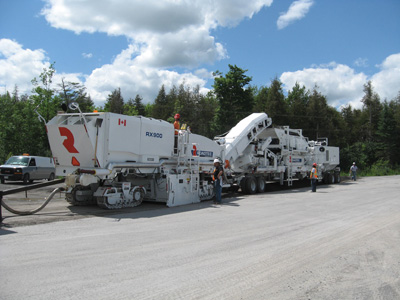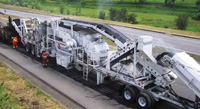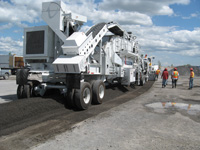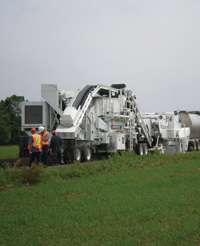
Features
Company Profiles
Roads & Paving
Cruickshank hops aboard CIR train
A Kingston, Ont.-based company is helping cold-in-place recycling paving become an industry trend.
October 18, 2010 By Rob Blackstien
Cruickshank Construction Limited’s recently completed paving project in
Port Colborne, Ont., not only ushered in a new era for the company, but
it continued a movement that’s gained momentum in the past few years –
specifically in Ontario.
Cruickshank Construction Limited’s recently completed paving project in Port Colborne, Ont., not only ushered in a new era for the company, but it continued a movement that’s gained momentum in the past few years – specifically in Ontario.
 |
|
| Cruickshank Construction Limited purchased the Roadtec RX-900 CIR train, which can be used for both cold-in-place and conventional milling. Photo courtesy of Cruickshank Construction Limited.
|
By making its initial foray into cold-in-place recycling (CIR) paving, this well-established Kingston, Ont.-based road builder and aggregate producer has helped validate that CIR – despite its frosty-sounding name – is a hot trend in the industry.
CIR consists of removing the top layer of the road, rejuvenating it on site and then laying it back down smoothly. As much as 100 per cent of the existing material can be reused, resulting in significant financial savings and environment benefits.
While CIR has been around for more than 30 years, skyrocketing asphalt and aggregate pricing, combined with a more environmentally conscious climate, is helping this process to gain traction, explains Eric Baker, marketing manager of Chattanooga, Tenn.-based Roadtec, the CIR train vendor of choice for Cruickshank.
 |
|
| The RT-500 cold recycler with paver loading conveyors, tandem dolly suspension and triple rear axle. |
Cruickshank is the first Canadian company – and just the third customer in the world – to purchase Roadtec’s most current CIR configuration, consisting of an RX-900 cold planer, an RT-500W cold recycler, a WP-180 windrow machine and an RP-195 asphalt paver (for more about the equipment, please see sidebar “Tech Specs”).
“We’ve been looking around at the cold-in-place for many years and watching the industry grow and the volume pick up in that area and we’ve had an interest,” says CEO Steve Cruickshank.
Cruickshank says that last winter he and David Semley, business development, engaged in more serious CIR discussions, ultimately deciding this was something the company should embark upon.
“So we did up a business case on it, evaluated it and then proceeded,” Cruickshank said.
Baker says the Roadtec train Cruickshank purchased costs close to US$2 million, not including other equipment such as rollers, tankers and support trucks.
That’s a sizeable investment, and it’s early days to be projecting the return on investment for the company, but Cruickshank says he’ll be very pleased if the CIR train pays for itself in four years.
Semley is equally bullish, if not as specific: “I think our expectation is that the payback for this equipment will be faster than what one would normally expect typical construction to be.”
 |
|
| Roadtec’s most recent CIR train configuration consists of an RX-900 cold planer, an RT-500W cold recycler, a WP-180 windrow machine and an RP-195 asphalt paver.
|
Clearly, the savings accrued from recycling asphalt (no hot-mix plant is required to produce asphalt, and the associated trucking involved with that is eliminated) are significant.
For instance, Baker says that the state of Nevada is saving US$180,000 per mile by using CIR instead of traditional mill-and-fill operations.
Semley says CIR is about 40 per cent less expensive than mill and pave projects. And then there are the environmental benefits: “Greenhouse gas emissions are approximately 50 per cent of traditional mill and pave,” he says.
Furthermore, Cruickshank says, less trucking is another significant benefit, as not only does it reduce traffic congestion, but it also translates into even more reductions in greenhouse gas emissions. Less expensive and environmentally friendly? Small wonder cold-in-place is heating up.
Of course, CIR won’t work everywhere. Because of the size of the train (approximately 100 metres long or – as Baker says, clearly having done his homework on all things Canuck before the interview – “about the size of a Canadian football field”) and the logistics involved, cold-in-place is not really a suitable solution for urban environments. City streets don’t tend to have the depth of asphalt necessary for this process either, Semley says.
CIR is ideal, Baker says, where the road has surface cracks, but the structure is sound and the granular base is deep enough to provide a good platform. To that end, Semley says that as a provincial highway with “a good, solid base and a good existing depth of asphalt,” the Port Colborne project was “an ideal candidate for cold-in-place.”
Semley says Cruickshank performed a “pavement rehabilitation project” in Port Colborne, where the company reclaimed 100 millimetres (four inches) of the existing pavement, reprocessed it and laid it back down with a surface course.
“You need a good granular base, a good platform,” Semley says.
“I mean, if we want recycle at 100 millimetres, and there’s only 50 millimetres of existing asphalt, that doesn’t work. In this case, there was probably almost 200 millimetres of existing asphalt and we reclaimed the top 100 and it gave us a good solid base.”
Semley says that Cruickshank gravitated towards this particular product because it was a turnkey solution. So far, so good for Cruickshank. “We’re finding the system is working well,” he says.
“The application is pretty broad; it’s applicable to county roads, secondary provincial highways,” he adds.
 |
|
| Steve Cruickshank, CEO of Cruickshank Construction Limited, has had interest in CIR paving for many years and is impressed with the labour and environmental benefits of it. |
In terms of previous systems he’s used, this CIR is “a little more sophisticated because of current technology in monitoring the various inputs – water and asphalt.”
But it was that ability – 100 per cent control over gradation and additive quantity – “that was the key selling point of this product versus other smaller products available,” Semley says.
The company was attracted to Roadtec because “they’ve been very proactive,” according to Cruickshank. Cruickshank is already planning its next CIR gig. In September, Cruickshank will be using the train for a 400-series highway project, Semley says.
For its part, Roadtec is thrilled that Cruickshank has hopped aboard the CIR train.
“They’ve been a very good customer of ours. They’re definitely a player in the Canadian market,” Baker says of Cruickshank. “We’re excited that this is kind of a new market for them and we’re glad that they chose us to partner with. So far it’s been a very good partnership for both of us.”
Rob Blackstien (rob.blackstien@rogers.com) is a freelance writer and the principal of Pen-Ultimate (www.pen-ultimate.ca), a Toronto-based writing and editorial services firm.
| Tech Specs Here’s the lowdown on the components of the Roadtec CIR train Cruickshank purchased: RX-900: A versatile cold planer, the RX-900 can be used for both cold-in-place and conventional milling. It can cut up to 14 inches deep and can be outfitted to work with different cutting widths. The RX-900 chews up the road to a certain profile and loads it onto conveyors and into trucks if necessary. At 950 horsepower, “it’s the biggest milling machine we build,” says Roadtec’s Eric Baker. It can range from a full lane’s width down to a half-lane by changing out the cutter. It has bi-directional functionality, so in traditional milling projects, the conveyor comes off the front for loading into trucks, but it can be turned around and operated in reverse for cold-in-place where you want to feed it into the trailer unit. RT-500W: This is the trailer unit where the material gets processed. The WP-180: After the RT-500W lays the material back down on the ground, the Ontario leading the way in CIR “From a U.S. perspective, we look at Canada as really the leaders of this process. Canada is so far ahead of us as far as cold-in-place that really it’s become kind of the home of cold-in-place, it seems – especially Ontario,” he says. “I think there’s a clear understanding at the provincial level of the benefits of this,” Semley says. Baker believes the reason why Canada is leading this market is because of more government buy-in. “It just seems to be more of a priority,” he says. “I think a lot of it probably boils down to politics,” Baker adds. “The Canadian market is just a lot more accepting of cold-in-place and they’ve done a lot more research at the agency level into this process, and honestly it’s where a lot of people go to look for specs, mix designs, those sorts of things.” |
Print this page
 Steve Cruickshank says that Ontario has been a real leader in this market since the mid-’90s. Roadtec’s Eric Baker agrees.
Steve Cruickshank says that Ontario has been a real leader in this market since the mid-’90s. Roadtec’s Eric Baker agrees.